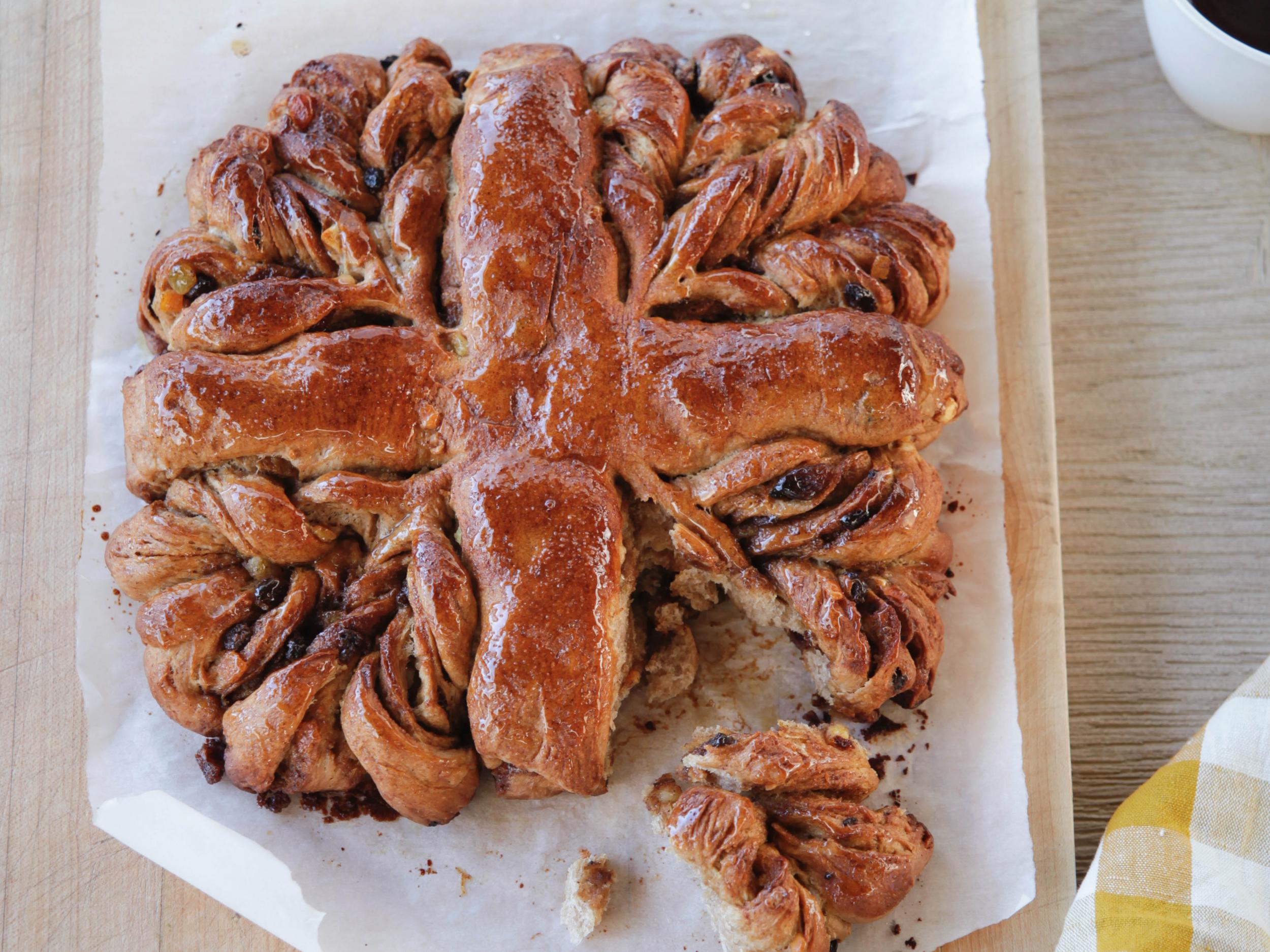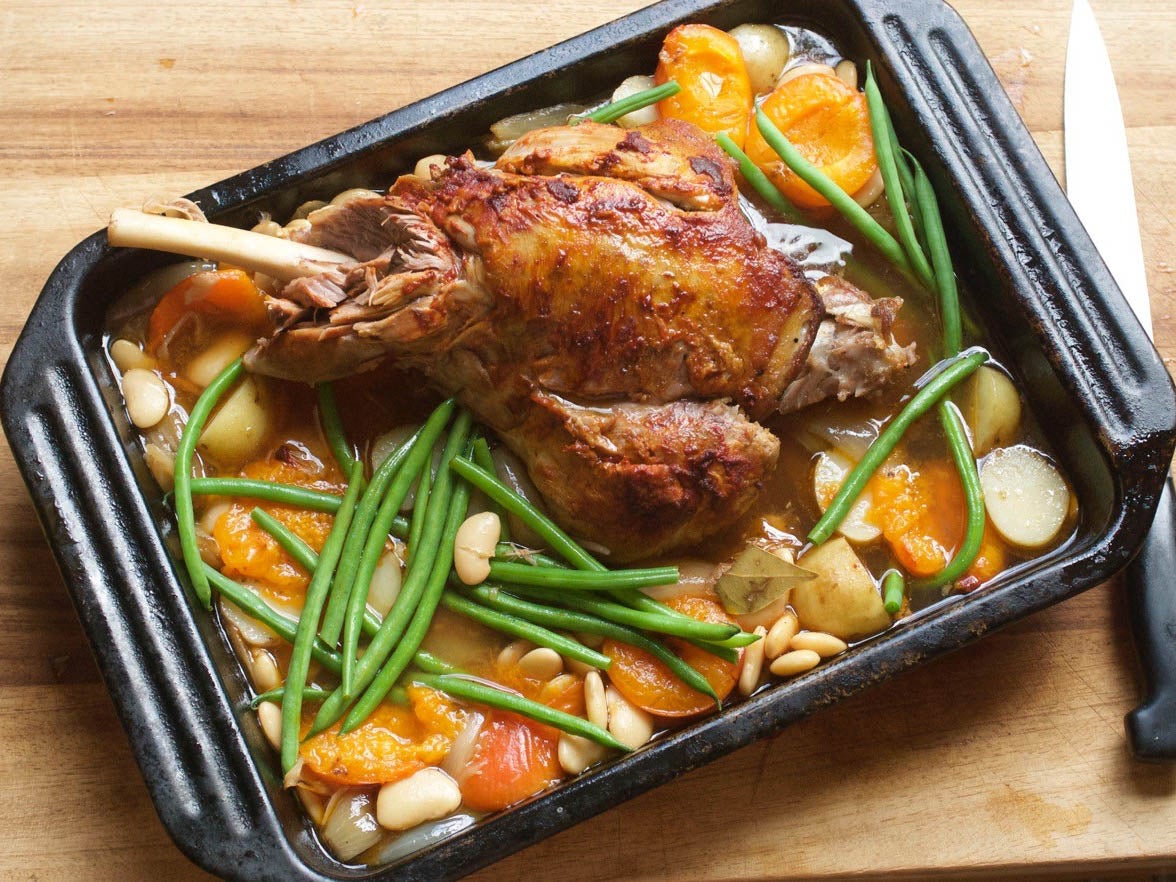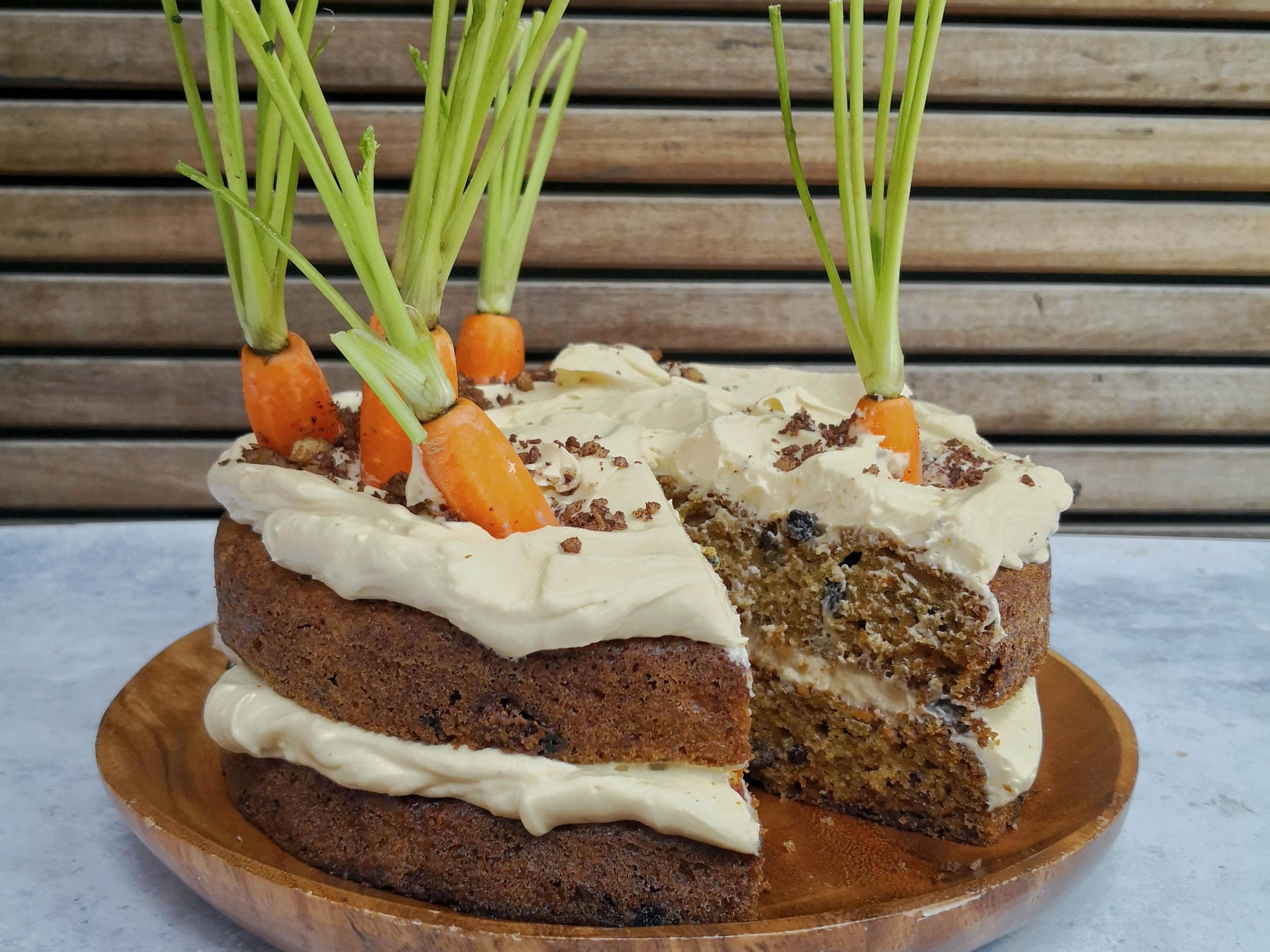Easter 2020: Recipes from hot cross bun twist to leg of lamb

Hot cross cinnamon twist
Serves 6-8
Time: 3 hours 20 mins
500g strong white flour, plus extra to dust
1 tsp mixed spice
2 tsp ground cinnamon
1 tsp salt
75g unsalted butter, cut into cubes
50g candied peel
50g raisins
110ml whole milk
220ml water
2 tsp (20g) golden syrup or honey
7g dried yeast
golden granulated sugar, to finish
For the sweetened butter filling
150g unsalted butter
70g brown sugar
1 tsp allspice
zest of 1 orange
25g raisins
25g candied peel
For the glaze
1 tbsp golden syrup or honey
1 tbsp fresh orange juice
1 tsp allspice
Sift the flour, mixed spice, cinnamon and salt into a large bowl. Add the butter then rub the flour and butter together with your fingertips until the butter is evenly distributed. Stir through the candied peel and raisins.
Warm the milk, water and golden syrup in a pan until the syrup has just melted. Test the temperature and if just warm (body temperature), stir through the yeast. You need to be careful that the liquid is not too hot otherwise it will kill the yeast.
Add the liquid to the flour mixture and, making a claw-like shape with your hand, combine the mixture to form a wet dough.
Dust a clean work surface with flour and knead the dough for about 10 minutes until it starts to tighten and look slightly silky.
Shape the dough into a ball and place in a bowl greased with a little olive oil. Cover with cling film and leave in a warm place for around 1 hour to prove, until roughly doubled in size.
Meanwhile, place all of the ingredients for the filling in a blender and blitz until you have a smooth buttercream. When the dough is ready, gently knock it back then divide it into four even-sized pieces. Shape each piece into a ball then roll the first out on a floured surface so that it is roughly 1.5cm thick and 25cm in diameter. Place on a baking tray lined with baking parchment and spread a third of the filling over the top. Roll out another of the balls of dough and place it on top of the first, spread with another third of the filling and repeat until all of the dough has been rolled and stacked.
Using a knife, cut the shape of a cross into the dough. Next, cut three diagonal slices between each of the edges of the cross (ie, to make four strips), being careful not to cut right into the centre. Take two of the quarters and twist them around each other three times, then press the ends together to seal.
Tuck in neatly and repeat with the remaining two quarters and then again with the other intersections of the cross shape. Cover the shaped dough with cling film and leave to rise in warm place for 1½ hours.
Preheat the oven to 180C.
Make the glaze by melting all of the ingredients together in a pan, then brush it all over the loaf. Sprinkle over the granulated sugar. Bake in the oven for around 45 minutes, or until just golden. It is worth keeping an eye on the loaf as it cooks. If any parts are looking like they are beginning to burn, simply cover with foil. When it’s baked, the loaf should sound hollow when tapped. Serve warm.

Slow-roasted leg of lamb with butter beans and apricots
Serves 6
Prep: 30 mins
Cook: 3-3½ hours
250g butter beans, soaked overnight (or 1 large 660g jar of Spanish cooked beans)
1 bay leaf
1 x 1½-2kg leg of lamb
3 medium onions, cut into quarters
5 garlic cloves, peeled and bruised
500ml vegetable stock
1 cinnamon stick
1 tsp sweet paprika
250g waxy or new potatoes, cut into bite-sized dice
6 apricots, stoned and halved
200g green French beans (you could use runners), trimmed
Preheat the oven to 160C. Drain the butter beans and place them in a pan of cold water with the bay leaf.
Bring the beans up to the boil, skimming off any froth with a ladle, then turn them down to a simmer and cook until tender (about an hour, maybe longer if the beans are older).
Meanwhile, season the lamb with salt and pepper, then brown it off on the hob in a large pan or, better still, the roasting pan with a couple of tablespoons of olive oil.
Add the onions and allow those to colour a little too. Throw in the cloves of garlic, still over the heat, and as soon as you can smell them pour in the stock and add the cinnamon stick.
Sprinkle the paprika over the lamb (transfer to the roasting tin if you were using a pan) and then cover the tin snugly with an airtight tent of foil.
Put the dish in the oven for 2½ hours and then add the potatoes, the drained butter beans and apricots. Cover again and cook for another 30-45 minutes, until the potatoes are cooked and the lamb is tender.
Remove the lamb from the pan and set aside to rest (use the foil to cover it). Add the green beans to the roasting dish and place it back in the oven for about 5 minutes, until the green beans are cooked through.
Taste the juices around the beans and adjust the seasoning with salt and pepper – you may even require a splash of lemon juice if the apricots were sweet.
Serve the lamb in chunky slices with the beans, potatoes and apricots (which will have almost collapsed into a sauce) and plenty of juice from the pan.
Alternative: Try substituting the apricots with quarters of peeled pear or quince, adding the quince for the last hour of cooking.
Recipe by Jenny Chandler at Borough Market

Carrot cake
For the sponges
200g light muscovado sugar
200ml sunflower oil
4 eggs
150g grated carrot
125g sultanas
Zest of 1 orange
1 tsp bicarbonate of soda
2 tsp mixed spice
200g self-raising flour
For the frosting
175g soft unsalted butter
350g unrefined icing sugar, sieved
1 tsp vanilla bean paste
150g cream cheese, at room temperature
For the decoration
2 tbsp hazelnuts, chopped
1 tsp cocoa powder
Approx 7 small, real carrots, ideally with their green tops (or marzipan/sugar carrots)
Preheat the oven to 180C and line the base and sides of 2 x 8in round cake tins.
In a large bowl, mix the sugar into the oil until the lumps have disappeared. Add the eggs and whisk through. Tip in the carrot, sultanas and orange zest and mix together.
In a separate bowl, mix the bicarb and spices with the flour, then add the flour mix to the wet mix and gently combine until just mixed. Divide between the lined tins.
Bake for 30-35 minutes, until the sponges are golden, springy and cooked through. Leave to cool in the tins for 5 minutes, then turn out onto a wire rack to cool completely.
Make the frosting by beating the butter, icing sugar and vanilla until pale, smooth and creamy, then gently beat in the cream cheese until just mixed through.
Trim the cakes if you need to and place one on your cake plate, board or stand. Spread or pipe over with a layer of the frosting. Place the second cake on top and cover generously with the frosting.
In a bowl, toss the chopped hazelnuts in the cocoa, then crumble over the cake where you want your ‘earth’ to be. Trim the carrots down and place around the cake, as if they are growing out from the cake, in a pretty pattern.
Join our commenting forum
Join thought-provoking conversations, follow other Independent readers and see their replies
Comments